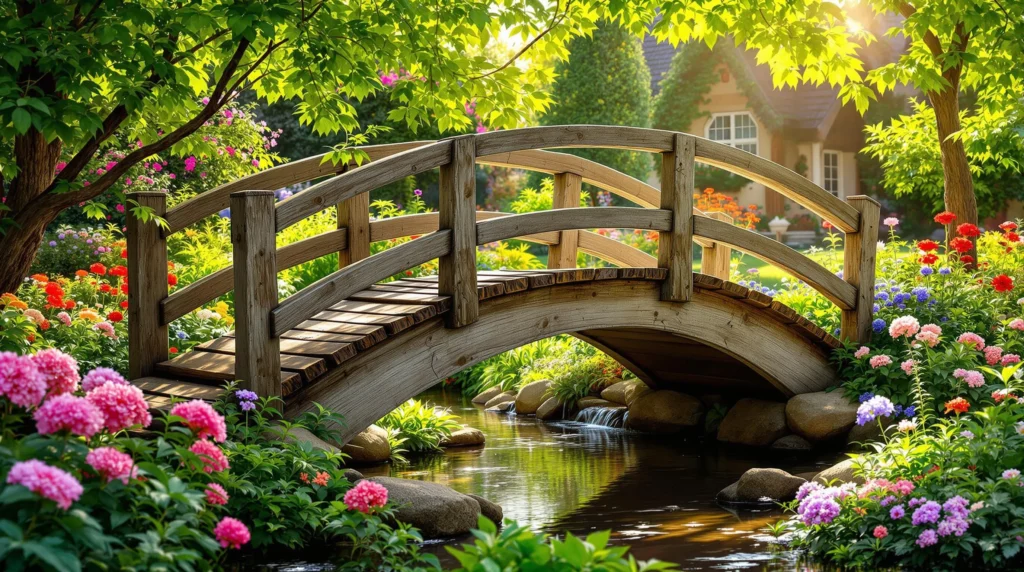10 Charming Garden Bridge Ideas to Transform Your Outdoor Space
- Rustic Wooden Plank Bridge – A simple wooden plank bridge adds instant country charm to your garden. These bridges use untreated or weathered wood to create a natural, lived-in aesthetic that works perfectly over shallow streams or dry creek beds. The rustic appeal comes from the straightforward construction and organic materials that blend seamlessly with woodland gardens.
- Elegant Arched Japanese-Style Bridge – Create a serene Asian-inspired garden space with a curved red or black lacquered bridge. These iconic structures instantly evoke the tranquil atmosphere of Japanese gardens and look stunning spanning over koi ponds. The graceful arch allows water plants to grow underneath while providing a perfect vantage point for viewing fish.
- Stone Slab Crossing – For a more permanent and maintenance-free option, consider flat stone slabs arranged as stepping stones or a continuous bridge. These natural stone crossings weather beautifully over time and blend perfectly with rock gardens or naturalistic landscapes. Large, flat stones like bluestone or granite create stable footing while maintaining an organic look.
- Covered Bridge Miniature – Add architectural interest with a scaled-down version of a classic covered bridge. These charming structures provide year-round visual appeal and offer shelter during light rain showers. The roof can be shingled to match your home or garden shed for a cohesive look throughout your industry.
- Modern Minimalist Bridge – Clean lines and contemporary materials like steel, glass, or concrete create a striking contrast against lush greenery. These bridges serve as architectural statements in modern industry designs, often featuring cable railings or sleek metal fabrication that complement updated outdoor spaces.
- Rope and Plank Suspension Bridge – Introduce a sense of adventure with a simple suspension bridge using rope and wooden planks. This playful design works well in informal gardens, especially those with a cottage or coastal theme. The gentle movement when crossing adds an interactive element visitors will remember.
- Recycled Material Bridge – Create an eco-friendly focal point using repurposed materials like railway sleepers, reclaimed lumber, or even bicycle wheels as decorative elements. These unique bridges showcase sustainability while adding personality to your garden. The weathered patina of recycled materials adds instant character and history.
- Stepping Stone Arc – For shallow water features or dry stream beds, consider an arc of large, flat stepping stones that hover just above the water surface. This minimalist approach creates the bridge effect without dominating the industry, perfect for contemporary or meditation gardens where subtle elements are preferred.
- Living Bridge with Climbing Plants – Construct a simple bridge framework that serves as a trellis for climbing plants like wisteria, roses, or clematis. Over time, these plants create a living canopy that transforms the bridge into a flowering tunnel. This option provides changing seasonal interest with blooms, foliage, and even fall color.
- Illuminated Evening Bridge – Incorporate subtle lighting into your garden bridge design with solar-powered LEDs along the handrails or underneath the structure. These lights create magical reflections on water at night and extend the usability of your garden into evening hours. The gentle illumination transforms your bridge into a focal point that can be enjoyed from indoor viewing areas after dark.
Creating a Rustic Wooden Garden Bridge for Natural Landscapes
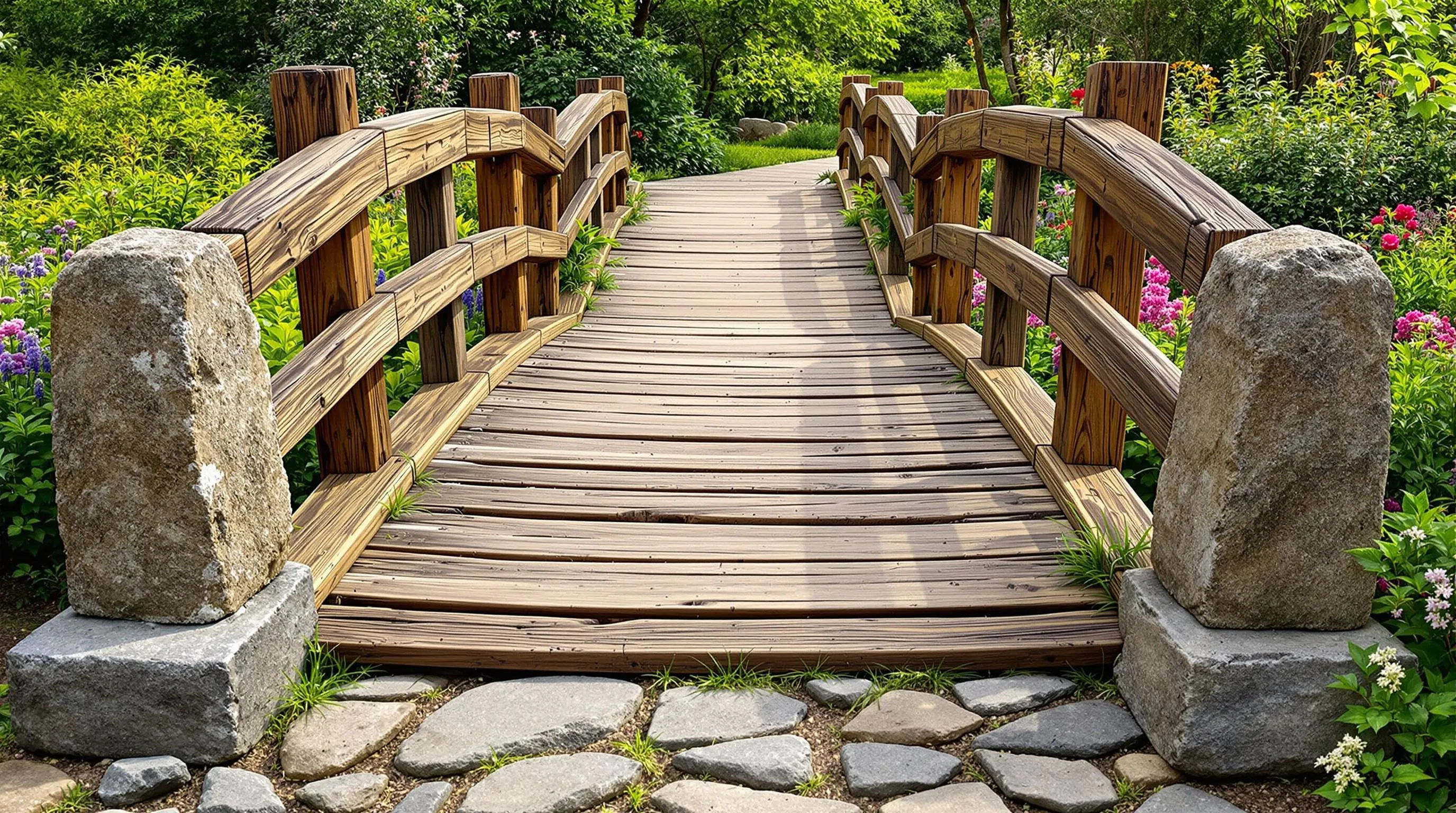
A rustic wooden garden bridge brings authentic charm to natural landscapes, creating a perfect harmony between man-made structures and organic surroundings. This traditional design works exceptionally well in cottage gardens, woodland settings, and naturalistic landscapes where a polished look would feel out of place.
Using Reclaimed Wood for Eco-Friendly Charm
Reclaimed wood offers unmatched character for your rustic garden bridge while providing important environmental benefits. Old barn wood, weathered fence posts, or salvaged timber from renovation projects carry unique patinas and textures that new lumber simply can’t replicate. When building with reclaimed materials, select pieces with similar weathering patterns and test each board for structural integrity before incorporation. Apply a natural oil finish rather than glossy polyurethane to preserve the wood’s authentic appearance while adding protection against moisture. The imperfections in reclaimed wood—nail holes, saw marks, and natural checking—become design features that tell a story and create visual interest in your garden crossing.
Incorporating Stone Accents for Stability and Style
Stone elements transform a simple wooden bridge into a standout garden feature while providing crucial structural support. Position flat, weathered stones at each end of your bridge to create solid abutments that prevent soil erosion and provide stable entry points. Consider adding stone pillars as bridge supports for longer spans, anchoring them securely below the frost line for year-round stability. Natural fieldstone complements rustic wood perfectly, creating a timeless combination that appears as though it’s always been part of the industry. For added visual interest, incorporate smaller stones along the sides of your bridge or create stone-lined pathways leading to each entrance, guiding visitors naturally toward your charming garden crossing.
Elegant Arched Bridges to Enhance Formal Garden Designs
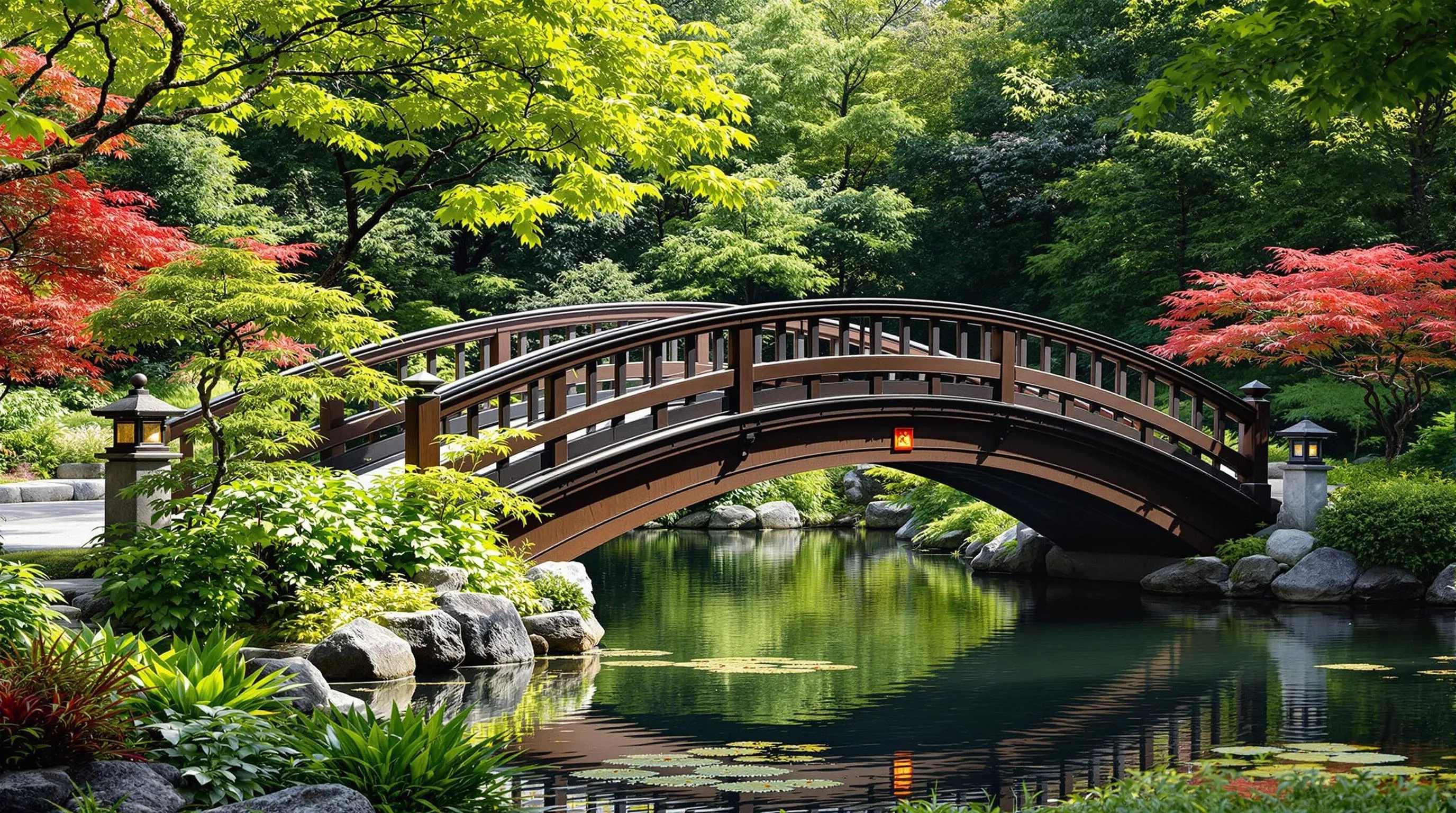
Arched bridges bring a sense of classical elegance to formal garden designs, creating graceful silhouettes that complement structured landscapes. These architectural features serve as stunning focal points while providing functional passage over water features or garden divides.
Japanese-Inspired Curved Bridges for Tranquil Spaces
Japanese-inspired curved bridges perfectly balance form and function in formal gardens, creating an immediate sense of tranquility. These distinctive structures feature high arches that allow boats to pass underneath while providing visitors with elevated views of the surrounding industry. The gentle curve creates a dramatic reflection in still water, doubling the visual impact. Traditional red-painted bridges offer striking contrast against green foliage, while natural wood finishes blend harmoniously with the environment. Consider adding bamboo railings or decorative lattice work to enhance the authentic Japanese aesthetic. These bridges work particularly well when paired with Japanese maples, cloud-pruned shrubs, and carefully placed stone lanterns to create a cohesive Eastern-inspired garden section within your formal design.
Moon Bridges for Reflecting Ponds and Water Features
Moon bridges earn their poetic name from the perfect circle created when their steep arch reflects in still water below. These dramatic garden structures originated in Chinese and Japanese garden design, where they symbolize the journey from earth to paradise. The distinctive high arc requires thoughtful placement over reflecting ponds where water remains calm enough to capture the complete circular illusion. The steep design encourages mindful, deliberate crossing—forcing visitors to slow down and appreciate the surrounding garden. For authentic styling, choose dark-stained hardwoods like cedar or redwood, and consider adding subtle lighting underneath to highlight the reflection at night. These statement bridges pair beautifully with water lilies, koi fish, and strategically placed boulders to create a contemplative space within your formal garden design.
Modern Minimalist Bridge Designs for Contemporary Gardens

Modern garden bridges feature clean lines, innovative materials, and architectural simplicity that perfectly complement contemporary outdoor spaces. These minimalist designs create visual impact through restraint rather than ornamentation, becoming sculptural elements in your industry.
Glass and Steel Combinations for a Sleek Look
Glass and steel bridges offer a striking aesthetic that enhances modern garden designs. The transparent glass panels create an illusion of floating across water or garden beds, while sturdy steel frames provide necessary structural support. These combinations work beautifully in urban gardens, rooftop spaces, or alongside contemporary architecture. Consider frosted or tinted glass panels for added privacy or visual interest, or opt for glass treads with LED underlighting to create a stunning nighttime feature. The reflective qualities of these materials also capture and amplify natural light, making your garden appear more spacious and ever-changing throughout changing daylight conditions.
Geometric Patterns in Modern Garden Bridges
Geometric patterns transform minimalist garden bridges into artistic statements for your outdoor space. Incorporate angular railings, hexagonal cutouts, or repetitive linear elements to create visual rhythm across your bridge design. Powder-coated aluminum in bold colors like matte black, charcoal gray, or even vibrant accent colors can enhance these geometric features while providing weather resistance. Consider how shadows cast by these patterns create secondary designs on pathways or water surfaces below, adding another dimension to your garden’s visual appeal. For maximum impact, pair these bold geometric bridges with simple plantings of ornamental grasses, bamboo, or other architectural plants that complement rather than compete with your bridge’s strong lines.
Whimsical Fairy Tale Bridges for Enchanted Garden Spaces
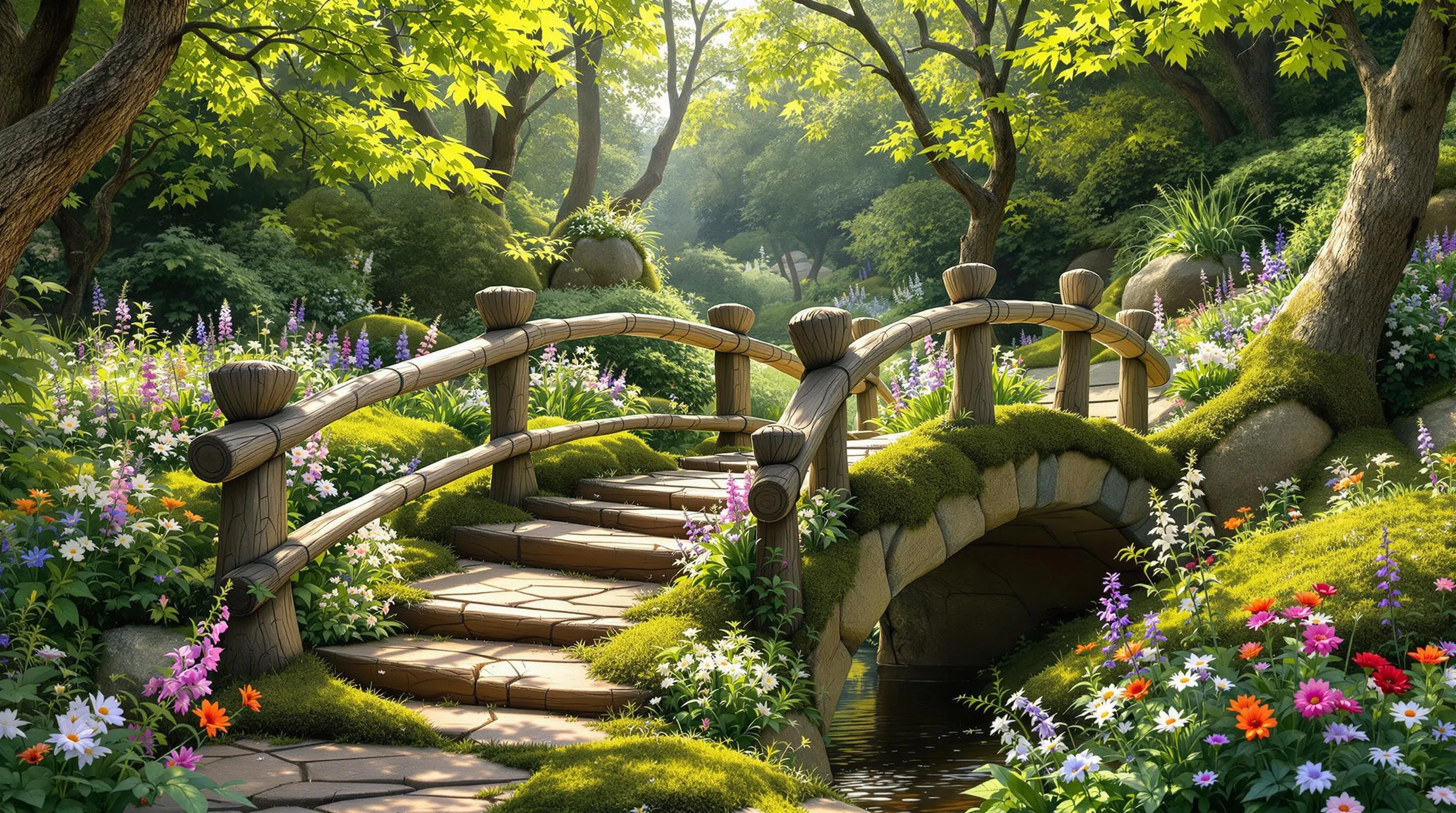
Transform your garden into a magical area with bridges that spark imagination and transport visitors to a industry of fantasy. Whimsical fairy tale bridges add an element of enchantment that captivates both children and adults alike.
Hobbit-Style Bridges for a Storybook Setting
Create a Middle-earth inspired retreat with a rounded hobbit-style bridge that instantly evokes the charm of fantasy literature. These bridges typically feature curved designs with rustic wooden railings and natural stone accents, making them appear as if they’ve sprung directly from a beloved storybook. You’ll want to enhance the magical atmosphere by planting lush moss around the bridge’s base and adding clusters of woodland flowers like primroses and foxgloves. For authentic hobbit appeal, incorporate rounded archways or tunnels into your design and consider weathering techniques to give your bridge an aged, established look. Pair your hobbit bridge with miniature doors on nearby trees or small fairy houses to complete your enchanted garden narrative.
Colorful Painted Bridges for Playful Garden Areas
Brighten your outdoor space with a vibrantly painted bridge that serves as both a functional crossing and a playful garden statement. Bold colors like ruby red, cobalt blue, or sunshine yellow transform a simple bridge into a cheerful focal point that pops against green foliage. You’ll find these bridges particularly effective in children’s play areas or cottage gardens where whimsy is welcomed. Weather-resistant outdoor paints ensure your colorful creation maintains its charm through changing seasons. For additional personality, incorporate painted patterns or motifs like flowers, stars, or rainbow stripes. Consider complementing your painted bridge with similarly colored garden accessories or flowering plants that echo your chosen hues, creating a cohesive and joyful garden atmosphere.
DIY Garden Bridge Projects for Budget-Conscious Homeowners
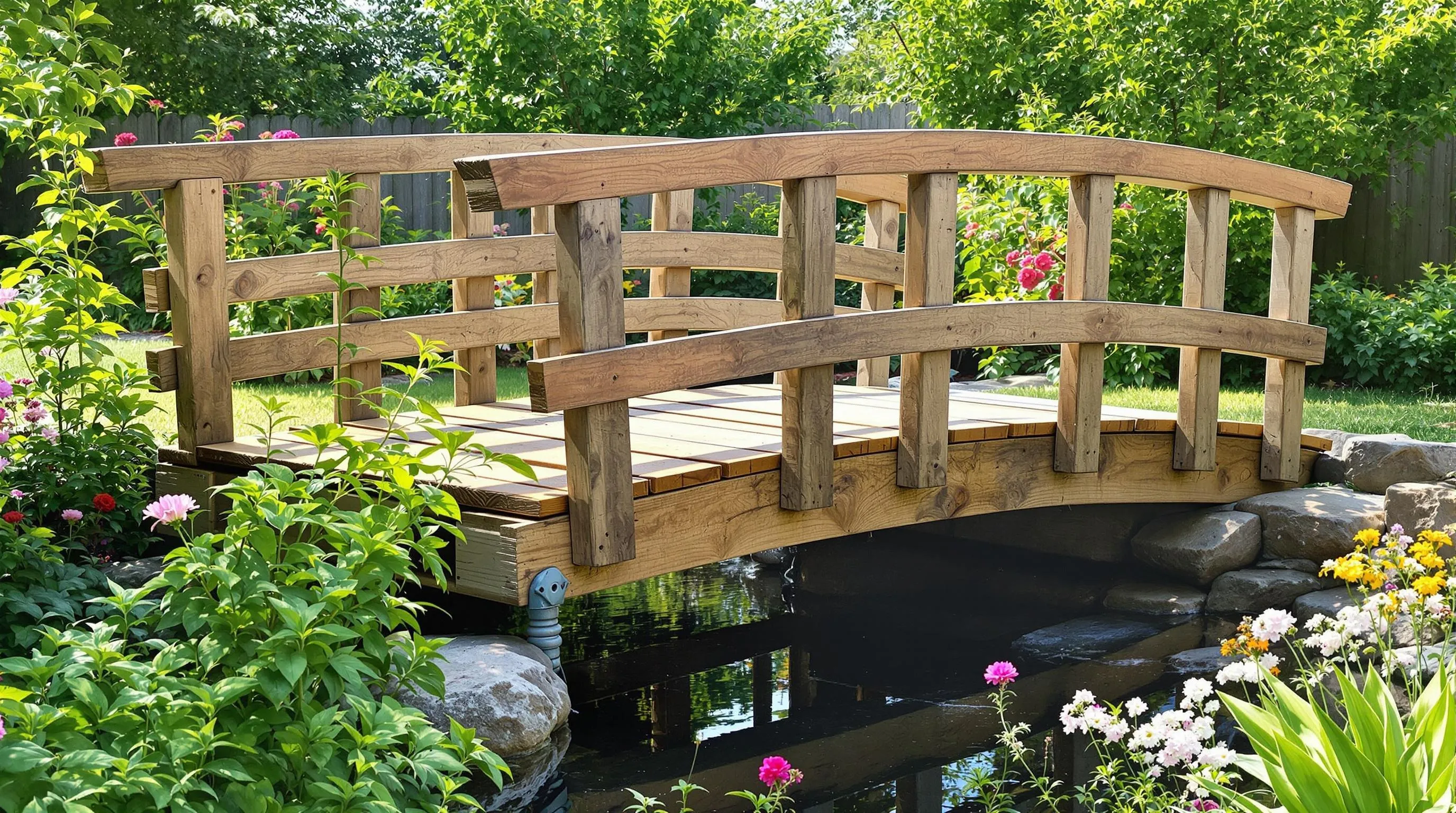
Creating your own garden bridge doesn’t have to expensive. With some basic materials and a weekend of work, you can create a beautiful bridge that enhances your outdoor space without the hefty price tag of pre-made options.
Pallet Wood Bridge Ideas for Upcycling Enthusiasts
Pallet wood bridges offer an eco-friendly and budget-conscious option for garden enthusiasts looking to add charm without spending much. Start by collecting 4-5 sturdy wooden pallets from local businesses that often give them away for free. Disassemble the pallets carefully using a pry bar and hammer, removing nails to prevent injuries. Sand all boards thoroughly to eliminate splinters and create a smooth surface. Design your bridge with a simple flat structure for smaller spans or add gentle arches by cutting curved supports from the thicker pallet pieces. Treat the wood with a non-toxic sealant to extend its lifespan against moisture and insects. For added stability, create side railings using vertical pallet slats attached to horizontal support beams. This upcycled bridge not only saves money but also gives discarded materials new life in your garden industry.
Simple Weekend Bridge Projects with Basic Materials
Transform your garden with a weekend bridge project using readily available materials from your local hardware store. A basic 4-foot garden bridge requires just 2×6 pressure-treated lumber for the walking surface, 2×8 boards for structural support, and 4×4 posts for stability. Begin by measuring and cutting your lumber according to your desired bridge dimensions. Create a simple arch by cutting curved sections into the 2×8 support boards using a jigsaw. Assemble the frame first, securing joints with galvanized deck screws that resist rusting. Attach decking boards perpendicular to the frame, leaving ¼-inch gaps between them for water drainage. Add simple railings using 2×2 balusters and a 2×4 handrail for safety and visual appeal. Complete your project by applying a weather-resistant stain that complements your garden’s color scheme. This straightforward bridge can be completed in a single weekend for under $150, providing both functionality and charm to your outdoor space.
Practical Considerations Before Building Your Garden Bridge
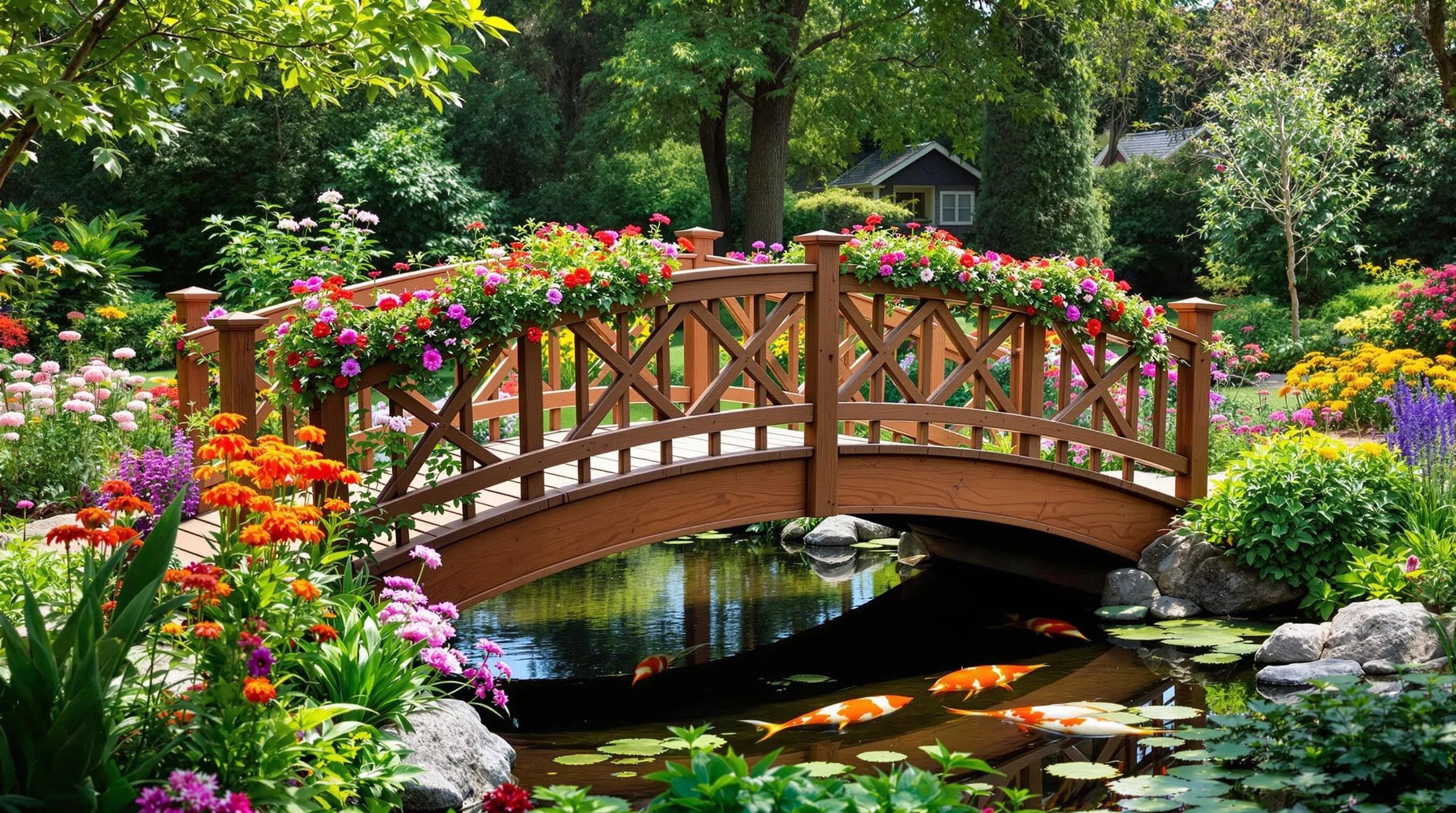
Before bringing your garden bridge dreams to life, you’ll need to address several practical factors to ensure your structure is safe, durable, and complements your industry. Taking time to plan these aspects will save you headaches and expenses down the road.
Weather-Resistant Materials for Long-Lasting Bridges
Selecting weather-resistant materials is crucial for your garden bridge’s longevity and appearance. Cedar and redwood naturally resist rot, making them excellent choices for wooden bridges that can last 15-20 years with proper maintenance. Pressure-treated lumber offers affordability and durability but requires periodic sealing every 2-3 years. For ultimate longevity, consider composite decking materials that blend recycled plastic and wood fibers, offering 25+ years of service with minimal upkeep. Metal bridges crafted from powder-coated aluminum or galvanized steel provide exceptional durability in wet environments, while stone or concrete structures offer virtually maintenance-free options that weather beautifully over decades. When selecting fasteners and hardware, opt for marine-grade stainless steel to prevent rust stains and structural weakness, especially for bridges spanning water features.
Safety Features to Incorporate in Your Garden Bridge Design
Your garden bridge must prioritize safety without compromising aesthetics. Install sturdy handrails (32-36 inches high) for bridges elevated more than 18 inches or spanning moving water. Ensure decking boards are spaced no more than 1/4 inch apart to prevent tripping while allowing proper water drainage. Add non-slip surfaces using textured paint, rubber strips, or naturally textured materials to prevent accidents during wet conditions. For nighttime safety, integrate subtle lighting along pathways or underneath railings—solar-powered options eliminate the need for complex wiring. Design your bridge with a gentle slope ratio (no steeper than 1:12) for comfortable crossing and accessibility. Finally, regularly inspect your bridge for loose boards, protruding nails, or deteriorating supports, establishing a seasonal maintenance schedule to address issues before they become hazards.
Garden Bridge Lighting Ideas for Evening Ambiance
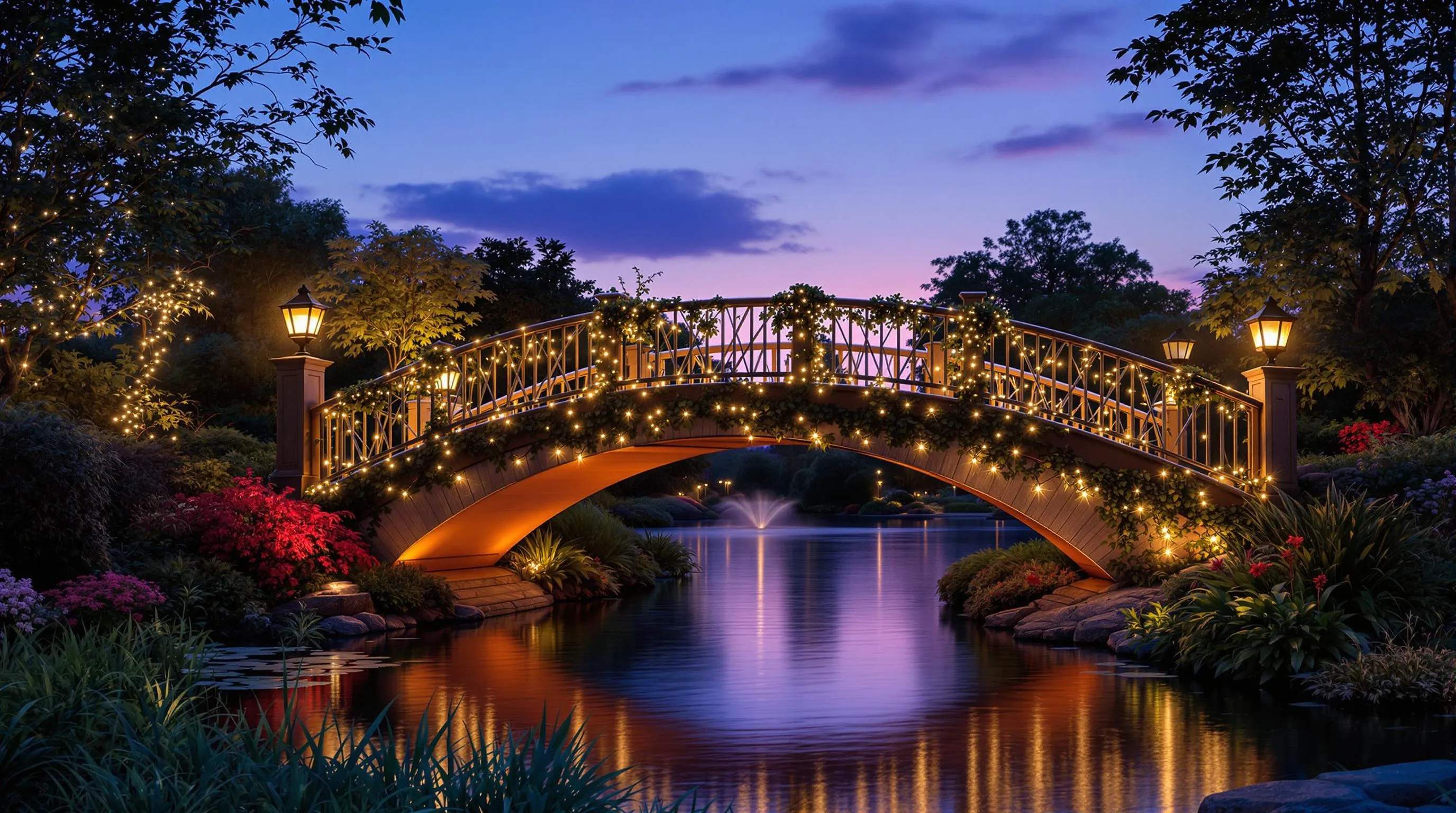
Transform your garden bridge into a captivating nighttime feature with strategic lighting that creates atmosphere and extends your outdoor enjoyment well after sunset. Proper illumination not only enhances safety but also showcases your bridge as an artistic focal point under the stars.
Solar-Powered Options for Eco-Friendly Illumination
Solar-powered lighting offers an environmentally friendly way to illuminate your garden bridge without increasing your electricity bill. These lights harness sunlight during the day and automatically activate at dusk, providing gentle illumination throughout the evening. Install solar path lights along the approach to your bridge or mount solar cap lights on posts for a soft, welcoming glow. Modern solar options include adjustable brightness levels and motion sensors for enhanced functionality. For maximum efficiency, position solar panels where they’ll receive at least 6-8 hours of direct sunlight daily, and clean them periodically to maintain optimal charging capacity.
Fairy Light Installations for Magical Night Gardens
Fairy lights transform ordinary garden bridges into enchanting nighttime destinations with their delicate, twinkling effect. Weave weatherproof LED string lights through railings or along the underside of your bridge to create a magical reflection on water features below. Choose warm white lights for a sophisticated look or multicolored strands for playful whimsy. Battery-operated or solar fairy light curtains can be draped from the bridge structure for a cascading waterfall effect that’s particularly stunning during special occasions. For year-round installations, invest in commercial-grade outdoor fairy lights with rubber gaskets that protect against moisture and temperature fluctuations, ensuring your bridge maintains its magical evening ambiance throughout the seasons.
Planting Around Your Garden Bridge for a Cohesive Look
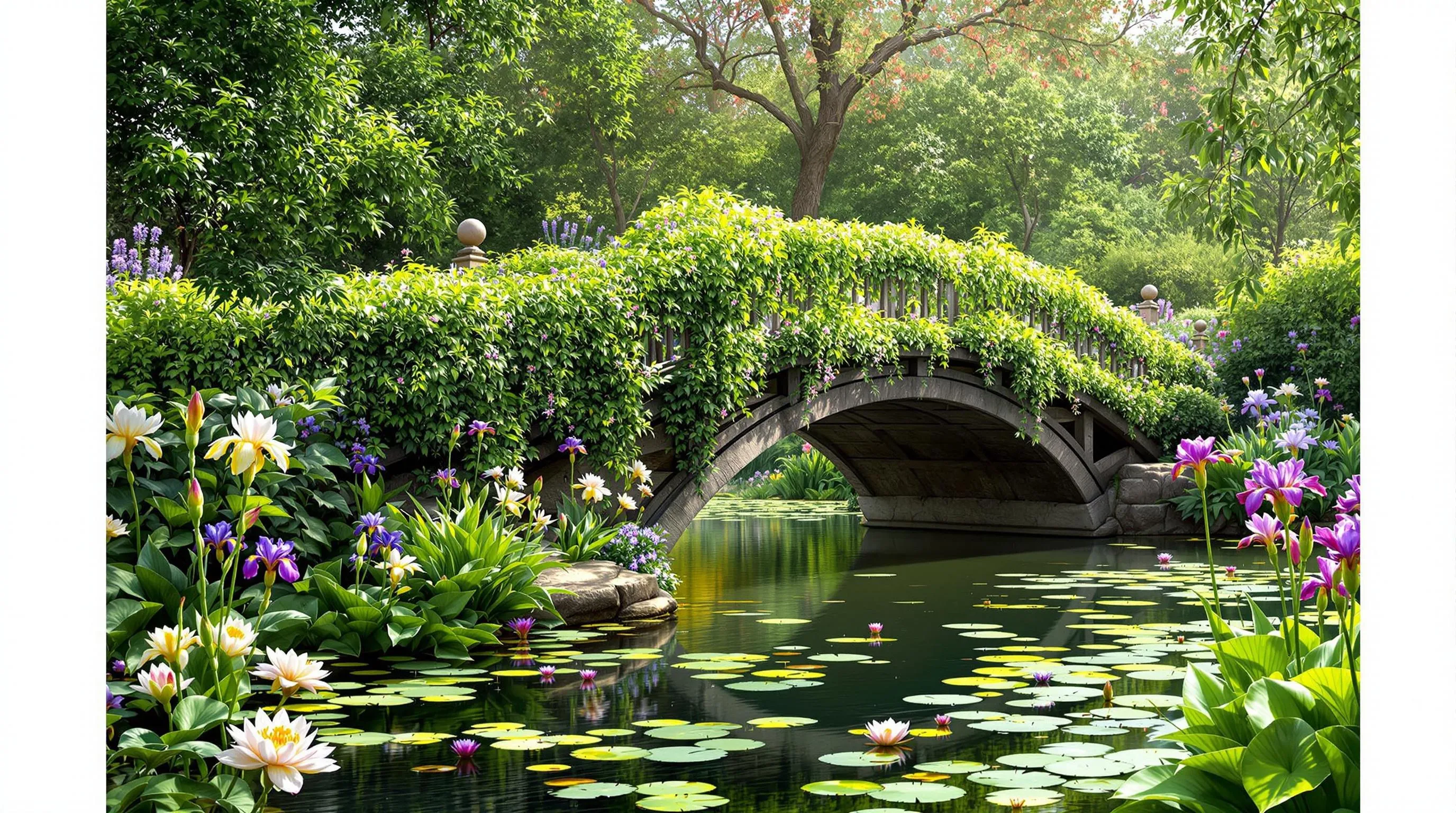
Creating a seamless integration between your garden bridge and surrounding industry elevates the entire design from simply functional to visually stunning. The right plant combinations can transform your bridge into a naturally flowing element of your garden’s story.
Trailing Plants to Soften Bridge Edges
Trailing plants beautifully soften the hard edges of garden bridges, creating an organic transition between structure and industry. Consider cascading varieties like creeping thyme or prostrate rosemary that spill over the sides, breaking up rigid lines with their flowing habits. Ivy cultivars offer year-round interest while clematis provides seasonal color explosions. For lower bridges, plant pendulous ferns or trailing sedums at entry points to create a welcoming invitation. These softening plants not only enhance aesthetic appeal but also help your bridge appear established and intentional rather than simply placed in the industry. Allow some trailing varieties to gently touch water surfaces for a truly magical connection between elements.
Water-Loving Plants for Bridge and Pond Combinations
Strategic placement of water-loving plants creates harmony between your bridge and water feature. Position Japanese iris, water lilies, and lotus plants near bridge foundations to establish a natural transition from land to water. Incorporate marginal plants like sweet flag, marsh marigold, and cardinal flower along shorelines to frame the bridge approach. Select varieties with contrasting heights—tall grasses like papyrus or reed canary grass provide vertical interest while spreading water mint creates carpet-like textures below. Consider seasonal blooming sequences to ensure year-round interest, with early spring marsh marigolds followed by summer-flowering pickerel and fall-blooming turtlehead. These water-loving plants not only enhance your bridge’s beauty but also support aquatic ecosystems, attracting beneficial wildlife that brings your garden to life.
Maintaining Your Garden Bridge Through the Seasons
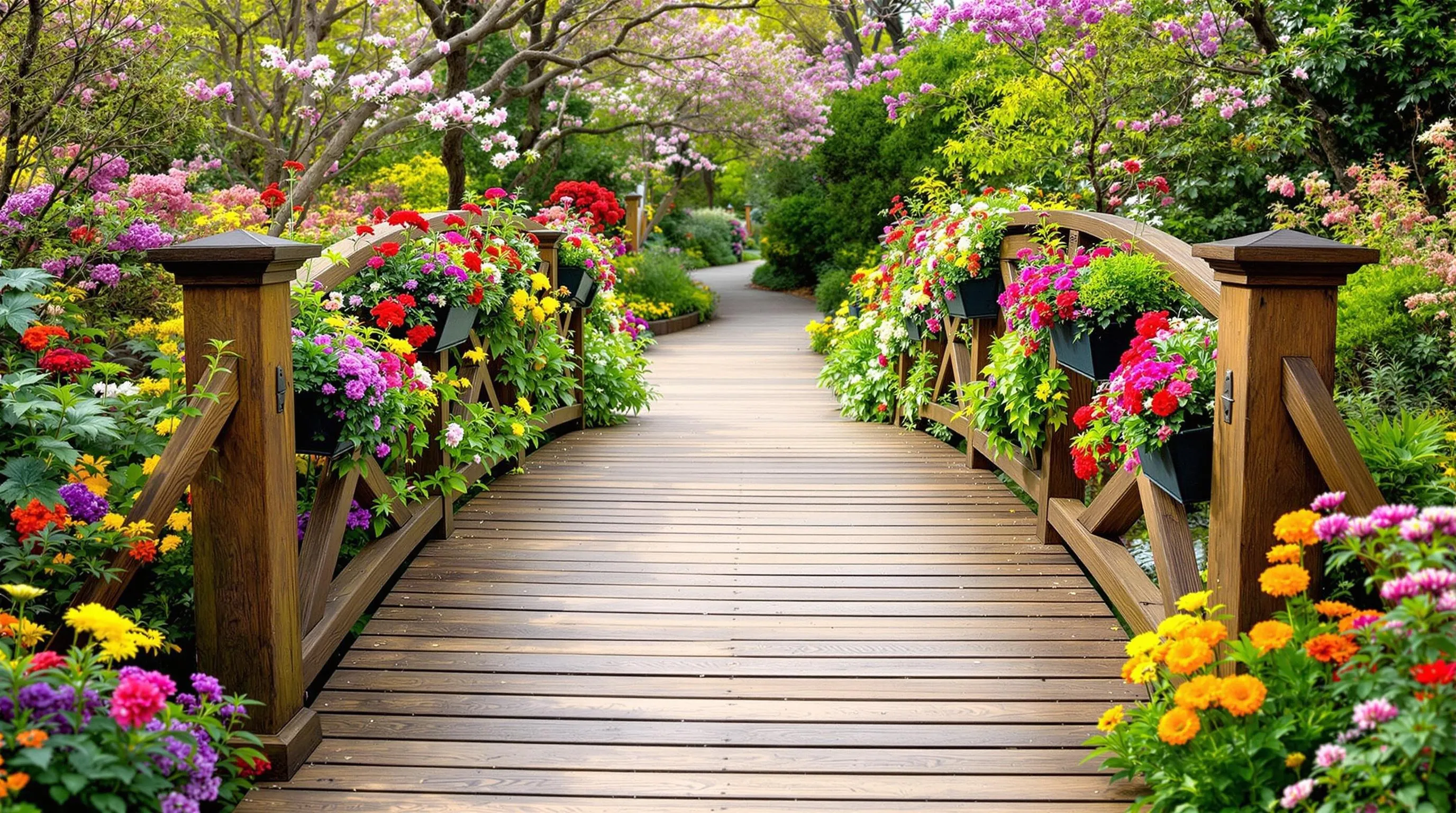
A garden bridge requires proper maintenance throughout the year to preserve its beauty and structural integrity. Seasonal care ensures your bridge remains a stunning focal point in your industry for years to come.
Weatherproofing Techniques for Extended Durability
Protecting your garden bridge from weather damage is essential for longevity. Apply a high-quality sealant or marine-grade varnish to wooden bridges every 1-2 years, ensuring complete coverage of all surfaces including underneath boards and railings. For metal bridges, check regularly for rust spots and treat them immediately with rust converter before repainting with outdoor-rated metal paint. Stone bridges benefit from annual inspection for loose mortar, which should be repaired promptly to prevent water penetration and freeze-thaw damage. During winter months, avoid using salt-based de-icers on any bridge type as they accelerate deterioration; instead, use sand or pet-friendly ice melt products when necessary. For bridges in areas with heavy rainfall, install proper drainage channels on approach areas to prevent water pooling and wood rot. Create a seasonal maintenance calendar with exact tasks for each bridge material type to ensure consistent care throughout the year.
Seasonal Decoration Ideas for Your Garden Bridge
Transform your garden bridge with seasonal decorations that celebrate each time of year. In spring, adorn your bridge with hanging baskets of colorful annuals like petunias or trailing lobelia, complemented by potted tulips or daffodils at each entrance. Summer calls for lush garlands of ivy intertwined with fairy lights, creating a magical evening atmosphere for outdoor gatherings. For autumn, weave a garland of preserved fall leaves and small pumpkins along railings, perhaps adding battery-operated candle lanterns for warm ambiance during early evenings. Winter decorations might include evergreen boughs sprinkled with pinecones, weather-resistant ribbon, and outdoor-rated string lights that create a welcoming glow against the winter industry. Consider creating custom seasonal wreaths to hang at bridge entrances, using materials that echo your garden’s palette while withstanding outdoor conditions. Always secure decorations properly to prevent them from becoming hazards during wind or storms, and avoid items that might leach harmful chemicals into nearby water features.
Conclusion: Choosing the Perfect Bridge to Elevate Your Garden Design
Your garden bridge can be more than just a decorative element—it’s a statement piece that reflects your personal style while serving a practical purpose. Whether you’re drawn to the timeless charm of rustic wooden designs or the sleek appeal of modern minimalist structures you’ll find a bridge style that harmonizes with your outdoor space.
Remember that the perfect garden bridge balances beauty with functionality. Choose weather-resistant materials appropriate for your climate and incorporate safety features to ensure years of enjoyment. With thoughtful planning lighting elements and complementary plantings your bridge will become the highlight of your garden.
By adding this architectural element you’re not just crossing a space—you’re creating a journey through your garden that invites pause reflection and appreciation of the natural beauty you’ve cultivated.

